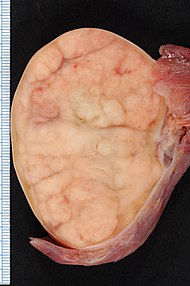

Definition of testicular cancer: Cancer that forms in tissues of the testis (one of two egg-shaped glands inside the scrotum that make sperm and male hormones). Testicular cancer usually occurs in young or middle-aged men. Two main types of testicular cancer are seminomas (cancers that grow slowly and are sensitive to radiation therapy) and nonseminomas (different cell types that grow more quickly than seminomas).![]()
Estimated new cases and deaths from testicular cancer in the United States in 2019:
New Case: 9,560
Deaths: 410
In the United States, between 7,500 and 8,000 diagnoses of testicular cancer are made each year.[1][2] Over his lifetime, a man’s risk of testicular cancer is roughly 1 in 250 (four tenths of one percent, or 0.4%). It is most common among males aged 15-35 years, particularly those in their mid-twenties. Testicular cancer has one of the highest cure rates of all cancers: in excess of 90%; essentially 100% if it has not metastasized. Even for the relatively few cases in which malignant cancer has spread widely, chemotherapy offers a cure rate of at least 85% today. Not all lumps on the testicles are tumors, and not all tumors are malignant; there are many other conditions such as Epididymal cysts, Hydatid of Morgagni, and so on which may be painful but are non-cancerous.
The above was obtained from both Wikipedia, and the American Cancer Society
©2023 Josh Robertson